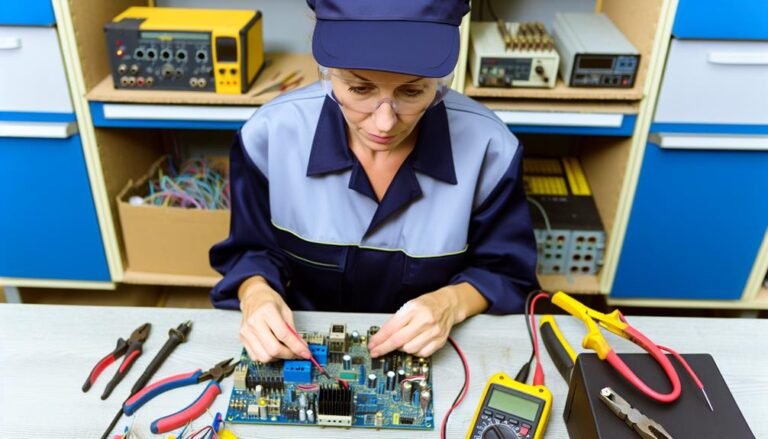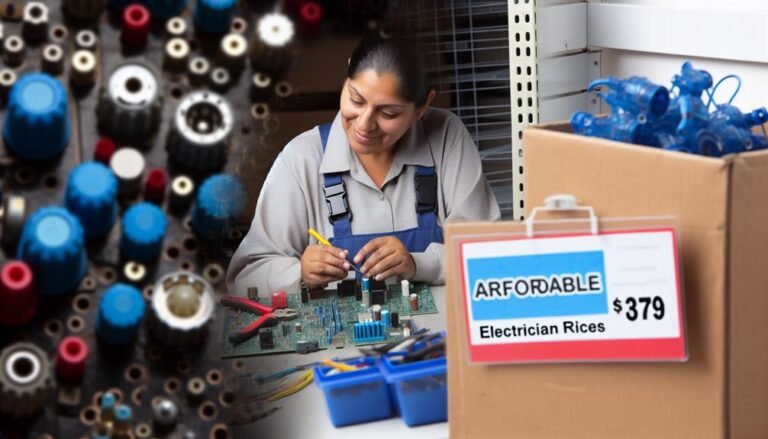Imagine this scenario: you're driving down the highway, enjoying the open road and your favorite playlist, when suddenly your car starts making a strange noise. You pull over and pop the hood, only to find smoke billowing out from the engine. Panic sets in as you realize you're in the middle of nowhere with no idea how to fix this unexpected problem.
Just like your car, electrical emergencies can catch you off guard and leave you feeling helpless. That's why it's crucial to know the best emergency electrical repairs in Tucson.
Whether it's troubleshooting power outages, fixing faulty wiring, resolving electrical fire hazards, or handling electrical shock incidents, these reliable solutions can save the day when you least expect it.
Stay tuned to discover the top-notch professionals who specialize in these urgent electrical repairs, as well as the essential tips and tricks they have up their sleeves to keep you safe and your home powered.
Key Takeaways
- Electrical surges can occur due to various reasons, such as lightning strikes, power outages, or faulty wiring. It is important to identify visible signs of damage and repair or replace damaged equipment immediately.
- Troubleshooting power outages involves checking the main circuit breaker for tripped switches, inspecting the circuit breaker panel for switches in the 'off' position, and resetting tripped switches. It is also important to inspect fuses and replace any blown ones.
- Fixing faulty wiring requires troubleshooting tripped circuit breakers, addressing damaged or faulty electrical outlets promptly, turning off the power supply before repairing or replacing outlets, and properly connecting wires to the new outlet.
- Regular inspection and maintenance of electrical systems are crucial to prevent accidents. It helps identify potential hazards, maintain the good condition of wires and outlets, and ensure proper usage and maintenance of electrical appliances.
Common Electrical Emergencies
In this section, we'll explore some of the most frequently encountered electrical emergencies and provide you with essential information on how to handle them effectively.
One common electrical emergency that you may encounter is an electrical surge. Electrical surges can occur due to various reasons, such as lightning strikes, power outages, or faulty wiring. When troubleshooting electrical surges, it's important to first identify the cause.
Inspect your electrical equipment for any visible signs of damage, such as melted wires or burn marks. If you find any damaged equipment, it's crucial to repair or replace it immediately to prevent further damage or potential hazards.
In some cases, you may need to reset your circuit breakers or replace surge protectors to mitigate the effects of electrical surges. Remember to always exercise caution when working with electrical equipment and consider seeking professional assistance if you're unsure about any repairs.
Troubleshooting Power Outages
To effectively troubleshoot power outages, start by checking the main circuit breaker for any tripped switches. This is often the first step in identifying electrical faults and restoring power.
Here are some power restoration strategies to help you get your electricity back up and running:
- Inspect the circuit breaker panel: Look for any switches that are in the 'off' position or in between 'on' and 'off.' Reset any switches that are tripped by flipping them to the 'off' position and then back to 'on.'
- Check for blown fuses: If your home has a fuse box instead of a circuit breaker panel, inspect the fuses to see if any of them are blown. Replace any blown fuses with new ones of the same amperage.
- Investigate other possible causes: If the circuit breakers and fuses appear to be fine, the problem may lie with a faulty appliance or a wiring issue. Unplug all appliances and turn off all light switches before resetting the circuit breakers or replacing fuses.
Fixing Faulty Wiring
When addressing faulty wiring, it is crucial to identify and rectify any potential electrical hazards. Faulty wiring can lead to power outages, electrical shocks, and even fires. To ensure the safety of your home and loved ones, it is important to troubleshoot circuit breakers and repair electrical outlets promptly.
One common issue with faulty wiring is tripped circuit breakers. A circuit breaker is designed to protect your electrical system from overloads and short circuits. When a circuit becomes overloaded or there is a fault, the circuit breaker trips, cutting off the power supply. To troubleshoot a tripped circuit breaker, follow these steps:
- Locate the circuit breaker panel in your home.
- Identify the breaker that has tripped by checking which one is in the "off" position.
- Reset the breaker by moving it to the "on" position.
- If the breaker trips again, it may indicate a larger issue and you should consult a professional electrician.
Another common issue with faulty wiring is damaged or faulty electrical outlets. If an outlet is not working or shows signs of damage, it is important to repair or replace it to avoid electrical hazards. Here are some steps to repair an electrical outlet:
- Turn off the power supply to the outlet by switching off the circuit breaker.
- Remove the cover plate and inspect the outlet for any visible damage.
- If the outlet is damaged, replace it with a new one of the same type.
- Make sure to properly connect the wires to the new outlet, following the manufacturer's instructions.
- Finally, reinstall the cover plate and switch on the power supply.
By addressing faulty wiring and promptly fixing any issues, you can ensure a safe and reliable electrical system in your home. Always remember to exercise caution when working with electricity and consult a professional electrician if needed.
| Troubleshooting Circuit Breakers | Repairing Electrical Outlets |
|---|---|
| Locate the circuit breaker panel in your home | Turn off the power supply to the outlet |
| Identify the breaker that has tripped | Remove the cover plate |
| Reset the breaker by moving it to the "on" position | Inspect the outlet for any visible damage |
| If the breaker trips again, consult a professional electrician | Replace the outlet with a new one |
Resolving Electrical Fire Hazards
To ensure the safety of your home and prevent potential electrical fires, it's crucial to address and resolve any electrical fire hazards promptly and effectively. Electrical fires can cause significant damage to your property and put your family's safety at risk. By taking proactive measures and following proper electrical safety guidelines, you can minimize the chances of an electrical fire occurring in your home.
Here are three important electrical safety measures to prevent electrical fires:
- Regular Inspection: Conduct regular inspections of your electrical system to identify any potential fire hazards. Look for signs of frayed wires, loose connections, or overheating outlets. If you notice any issues, such as flickering lights or burning smells, it's important to contact a qualified electrician immediately to address the problem.
- Upgraded Wiring: Outdated or faulty wiring can increase the risk of electrical fires. Consider upgrading your wiring system to meet current safety standards. This will ensure that your electrical system can handle the demands of modern appliances and reduce the risk of electrical fires caused by overloaded circuits.
- Proper Use of Electrical Appliances: Misusing electrical appliances can lead to electrical fires. Always follow the manufacturer's instructions for proper use and maintenance. Avoid overloading outlets, and never use damaged or frayed cords. Unplug appliances when not in use and never leave them unattended.
Handling Electrical Shock Incidents
Handling electrical shock incidents requires immediate action and proper knowledge to ensure the safety of those involved. When faced with an electrical shock incident, it's crucial to act swiftly while prioritizing safety.
The first step is to immediately disconnect the power source before approaching the affected individual. Don't attempt to touch or move the person until the power is off, as you may also become a victim of the shock.
Once the power is off, carefully assess the situation and call for medical help. If the individual is unconscious and not breathing, initiate CPR immediately. Remember, never administer CPR while the person is still in contact with the electrical source.
When it comes to treating electrical burns, it's essential to avoid using any ointments, creams, or home remedies. Instead, cover the burn with a sterile dressing and seek medical assistance promptly.
To prevent electrical accidents, always ensure that electrical outlets are properly covered, wires are in good condition, and electrical appliances are used and maintained correctly. Regular inspection and maintenance of electrical systems are essential to identify potential hazards and prevent accidents from occurring.







